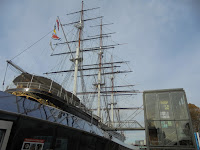Greenwich.
London SE10 9NN
Thursday November 24
2016
There is much to see
in Greenwich‘you need more than day’ say the posters and that is absolutely
true. Today was our second visit in two weeks and third overall and there will
be more to come.
The best approach for
Wren’s masterpiece (this or St Pauls’ – you choose) is of course by river but
we took the DLR route today and made our way into the side entrance of the visitor
centre. This is a slightly strange mixture of a tourist office with tours and
information specific to Greenwich but also somewhere offering London-wide leaflets
(it was here, back in 2008 I picked up the four London bus maps which started
us on our eventual 5 year bus odyssey), a café and substantial toilets but
threaded through these there is as well a history of the site and above all the
buildings. This I suppose dignifies this
visit as a museum rather than a generic look at buildings.
In the far corner (I
think this should be more central as chronologically it comes earliest) are the
displays relating to the original Tudor Palace, in the main erected by Henry
Tudor (VII) as he took over the kingdom following the Wars of the Roses – it
was to be the birthplace of three future and very memorable monarchs: Henry
VIII, Mary and Elizabeth. The palace extended along the riverfront where even now
they are finding interesting artefacts as the foreshore recedes and included a friary
and a chapel. The Friary, which put up
some criticism of Henry’s ‘marriage plans’ was of course the first to go with
William Peto (who had been Katherine of Aragon’s confessor) imprisoned and
exiled for preaching a rather controversial anti-Anne Boleyn sermon. The
exhibits here include Tudor rose plasterwork embellishments and fragments of
the chapel floor and windows plus a ground plan of what was a very substantial
site. After Elizabeth’s death the palace was abandoned and as other noble
(hangers-on?) local families left also land changed hands...
Chronologically the
next significant building was the Queen’s House (which will form the basis of a
separate blog) but its very position, perched halfway up the hill, determined
the design of what was to be the Seamen’s Hospital down by the river. The
displays in the Visitor Centre backed by video commentary (Dan Cruickshank who
sadly has appropriate things to say but says them in such an annoying way I
tend to switch off – is it only me?)
focus on several aspects of architecture looking at the building
materials, the design and the specification – in this case somewhere for the
pensioned/retired and almost invariably disabled ex-seamen to live. Wren had
precedent here with the formidable Chelsea Royal Hospital for army veterans At Greenwich his brief
was more complex as he needed to allow for the river frontage and leave a clear
view up to the Queen’s House. The result was a hugely pleasing symmetrical
building of open courtyards with two domed communal buildings – the chapel and
dining room, so plenty of room for the residents to take the air, watch the
river and probably smoke… The stone has worn well and the life of Wren
points out that he had a strong sense
of civic duty, which indeed is his legacy of several great public buildings.
There are reconstructions of what a seaman’s room might have been like (some
were communal) and an idea of how he might have spent his day; according to
this hardly one of riotous living. The project had originally been that of
Queen Mary but when she died of smallpox the surviving William III completed it.
Among its Governors was former Admiral Hardy who had served so memorably with
Nelson, which must have been a thrill for the pensioners who much admired
Nelson. (The main Maritime Museum has an exhibition looking at the life Emma
Hamilton, but that’s for another day).
There were two
intriguing wooden statues, not unlike the figure-heads we had seen round the
corner two weeks ago, called ‘Gin’ and (slightly fatter) ‘Beer’, which
apparently adorned the buttery where the pensioners ate.
We did go out to look
at the Dining Hall which is considered very worthwhile – however it is
currently closed for a major renovation and when re-opened will apparently
(presumably at a cost) include a raised walkway the better to be able
to admire James Thornhill’s painted ceiling. We still remember when the Dining
Room was the naval college’s and smelt persistently of cabbage…
The Chapel is equally
handsome and beautifully proportioned with some intricate Coade Stone on the
ceiling – this is a later building as fire had demolished the original chapel.
By the late 19th
Century the Seamen’s Retreat was losing numbers as post Waterloo there were
fewer conflicts thus fewer casualties of war and those there were preferred to live at home.
It took a mere four years to turn the Hospital into a college for the training
of Royal Naval Officers, which opened in 1873 under the auspices of Sir Astley
Cooper Key. It took students from round the world and eventually trained the
merchant marine also. When I said to Jo that it seemed a bit late in the day to
be training folk she pointed out that previously the officers had bought their
commissions and other ranks were ‘press-ganged’.
Within 40 years they
would be training sailors for war and essentially focussed only on ‘hostility’
training thereafter. There had been training facilities in Portsmouth both
before they moved here and after they moved back to the South West. Their
motto indicates they embraced (not literally we hope?) the training of women
also.
(Minerva as well as Mars..)
These buildings have
now been taken over by the University of Greenwich and the students were much
in evidence today as we left this lower part of the Unesco heritage site.


















































